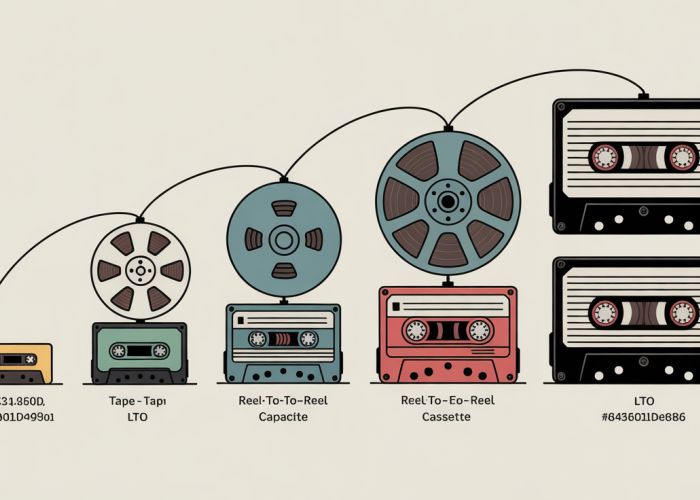Data archival solutions are evolving, and the ongoing debate surrounding magnetic tape capacity remains critical for organizations managing exponential data growth. Specifically, the capacity limitations influence decisions related to Linear Tape-Open (LTO) technology deployments. Considerations of cost alongside the data storage requirements of companies like Iron Mountain are central to the discussion. Analyzing the scalability of Quantum Corporation’s tape libraries is essential to determine if their solutions will address the ever-increasing needs of data centers around the globe and their challenges with magnetic tape capacity.

Magnetic Tape Capacity: Will It Ever Be Enough?
Magnetic tape technology, despite its age, remains relevant, particularly in data storage environments demanding high capacity and long-term archiving. The central question, however, persists: will magnetic tape capacity ever truly be sufficient for the ever-growing demands of modern data? To adequately address this, we must dissect the factors driving capacity demands, assess current technological limitations, and explore potential future developments.
Understanding the Capacity Demands
The relentless growth of data, fueled by advancements in fields like artificial intelligence, scientific research, and video surveillance, directly impacts the perceived "sufficiency" of any storage medium, including magnetic tape.
- Data Growth Drivers:
- Increased Resolution & Complexity: Higher resolution images, videos, and simulations generate massive datasets.
- IoT Expansion: The proliferation of Internet of Things (IoT) devices leads to a constant stream of sensor data needing storage.
- Regulatory Compliance: Data retention mandates for legal and regulatory purposes require organizations to store data for extended periods.
- The Challenge of Scale: Meeting these capacity demands requires not just larger tapes, but also improved data management strategies and efficient archiving workflows.
Current State of Magnetic Tape Capacity
Understanding the current landscape of magnetic tape capacity requires examining leading tape formats and their technological underpinnings.
Current Leading Tape Formats
The Linear Tape-Open (LTO) format currently dominates the market.
| Format | Native Capacity (per cartridge) | Compressed Capacity (typical 2.5:1) |
|---|---|---|
| LTO-9 | 18 TB | 45 TB |
| LTO-8 | 12 TB | 30 TB |
| LTO-7 | 6 TB | 15 TB |
These figures represent the raw capacity of the physical tape itself. Compression ratios achieved in real-world scenarios can vary depending on the type of data being stored.
Technological Limitations Affecting Capacity
Several factors inherently limit the achievable magnetic tape capacity.
- Track Density: The ability to write more data tracks onto a given area of tape is a primary constraint. Increasing track density requires more precise read/write heads and improved tape formulations.
- Linear Density: The amount of data that can be stored per unit length of tape is another crucial factor. Improving linear density necessitates smaller magnetic grains and more sensitive read/write heads.
- Tape Formulation: The magnetic material coating the tape directly impacts its capacity. Research continues into new materials with higher magnetic coercivity and improved signal-to-noise ratios.
Future Prospects and Potential Breakthroughs
Addressing the future sufficiency of magnetic tape capacity hinges on innovations and advancements in several key areas.
Emerging Technologies to Boost Capacity
- Heat-Assisted Magnetic Recording (HAMR): HAMR uses lasers to heat the tape surface during writing, enabling the use of higher coercivity materials and increasing bit density. This offers the potential for significantly increased capacity.
- Barium Ferrite (BaFe) Particles: BaFe provides superior signal-to-noise ratio compared to traditional metal particles, allowing for higher recording densities. It is widely used in LTO tapes.
- Improved Servo Technology: More precise servo systems are necessary to accurately position the read/write heads on increasingly narrow tracks, ensuring data integrity and maximizing storage capacity.
- Three-Dimensional Recording: Exploring the possibility of stacking multiple layers of magnetic material to increase the areal density of the tape. However, this is still a theoretical concept.
Data Compression and Deduplication Techniques
While not directly increasing the physical capacity of the tape, advanced data compression and deduplication algorithms can significantly improve the effective storage capacity. These techniques can be implemented at the hardware or software level.
- Algorithm Efficiency: Continued refinement of compression algorithms to maximize the reduction in data size without compromising data integrity.
- Hardware Acceleration: Integrating compression and deduplication directly into tape drives to minimize performance overhead.
- Intelligent Data Management: Developing data management systems that automatically identify and eliminate redundant data blocks before archiving them to tape.
Magnetic Tape Capacity: Frequently Asked Questions
Why is magnetic tape still used when we have hard drives and SSDs?
Magnetic tape offers a significantly lower cost per terabyte compared to hard drives and SSDs, making it ideal for long-term data archiving. It also has a very long lifespan when properly stored.
How does magnetic tape capacity compare to other storage options today?
Magnetic tape cartridges currently offer capacities in the tens of terabytes, with future generations expected to reach even higher. This places it competitively with high-capacity hard drives and offers a cost-effective solution for massive data storage.
Is magnetic tape technology still being actively developed?
Yes, research and development continue to push the boundaries of magnetic tape capacity. New materials and recording techniques are constantly being explored to increase data density and overall storage capability.
What are the limitations of using magnetic tape capacity for primary data storage?
The main limitation is access speed. Magnetic tape requires sequential access, meaning data must be read in order, unlike the random access provided by hard drives and SSDs. This makes it unsuitable for applications requiring quick data retrieval.
So, that’s a wrap on magnetic tape capacity! Hopefully, you found some useful nuggets in there. Keep exploring, and maybe one day we’ll finally crack that ‘enough’ puzzle, right?